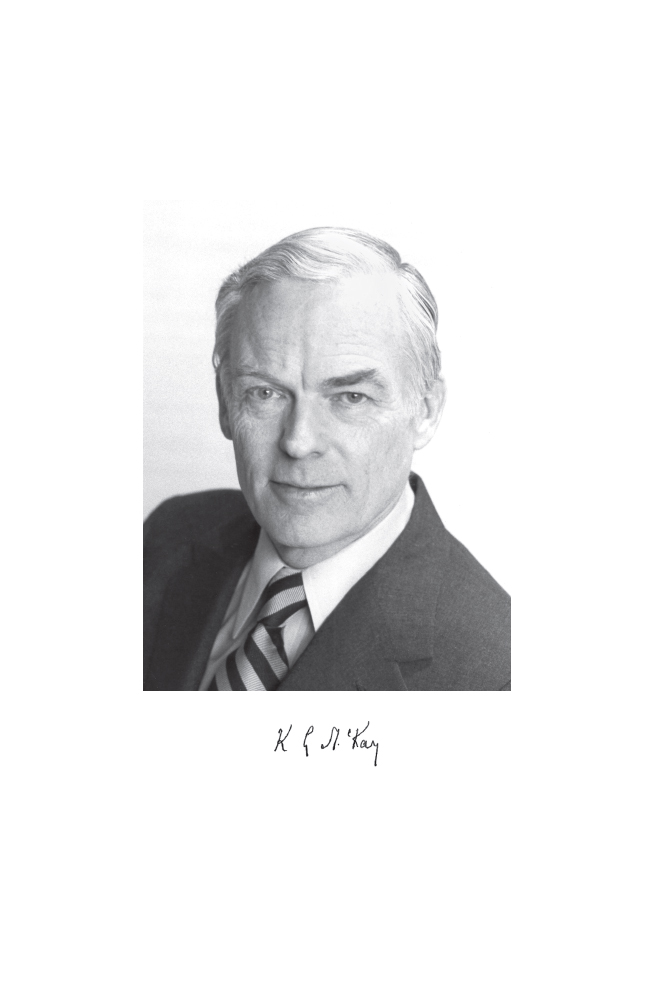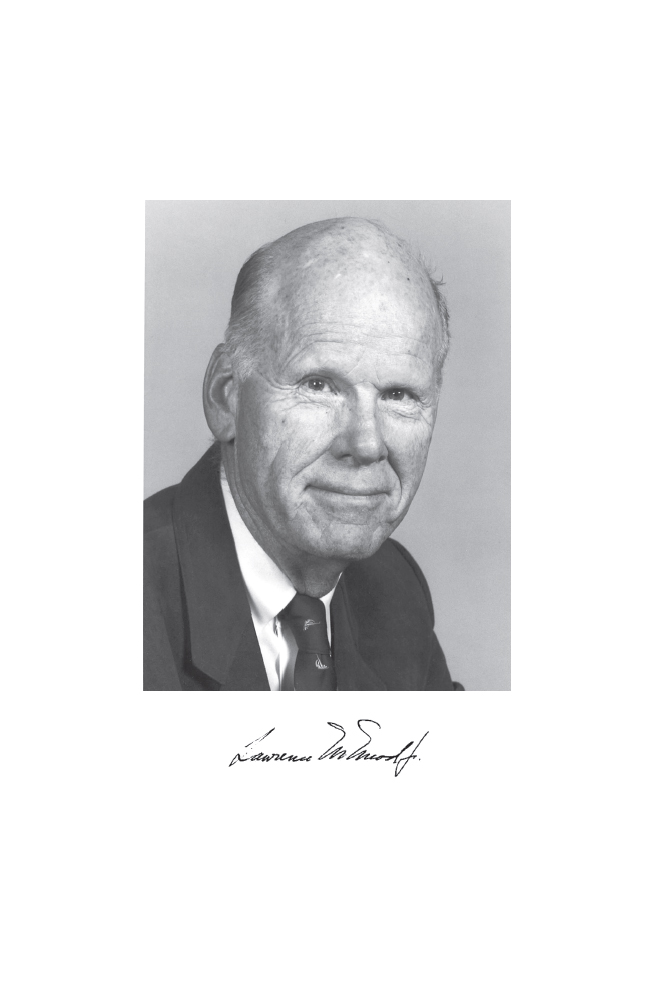
1917–2010
Elected in 1968
“Developments in communications, especially in systems engineering and management of technical advances.”
BY WOLCOTT DUNHAM
SUBMITTED BY THE NAE HOME SECRETARY
KENNETH GARDINER McKAY, physicist and executive of Bell Telephone Laboratories and AT&T, died March 5, 2010, in New York City at the age of 92. He had a long career that combined physics and engineering, and his publications included papers on avalanche breakdown in semiconductors and interactions between electrons and solids.
KG, as he was affectionately known by his many friends, was born April 8, 1917, in Montreal. Starting with an amateur radio receiver and transmitter he built while still in grade school in Montreal, he took an early interest in physics and electronics, as he explained in a letter to his daughter:
I started with a fascination with what makes things tick, which led to a lifelong involvement with physics—the desire to understand the world of nature—atoms and electrons, stars and gravity waves, and everything in between. However, I also wished to create things to be used which, starting with amateur radio, led to engineering. …Then back to physics research at Bell Labs. After establishing a world reputation in solid state physics (now called condensed matter physics) I shifted to the development of devices followed by years of systems engineering, both at Bell Labs and at AT&T. As an officer of the largest corporation in the world, I attempted to introduce technical concepts into the thinking of my fellow officers.…
This shifting back and forth between physics and engineering has had a common technological basis. This also underlies my participation in advisory committees to Stanford, University of California, MIT, the National Academies of Sciences and Engineering. A scientist does not have to be a narrowly focused person as he/she is often portrayed. By applying the fundamental principles of research, the scientist can happily enter many fields of endeavour and contribute usefully by exercising a different viewpoint. This is a capsule of one scientist’s career. It has all been enjoyable.
At McGill University KG earned a BSc in 1938, winning the Anne Moldson Gold Medal for Mathematics and Natural Philosophy, and an MS in 1939. He received a Moyse Traveling Fellowship to support further graduate study at Oxford University, but the start of World War II prevented his attendance, so he earned his doctorate in physics from the Massachusetts Institute of Technology in 1941. He returned to Canada and designed radar equipment during wartime service with the National Research Council of Canada in Ottawa (1941–1946). After the war, he came to the United States and joined Bell Telephone Laboratories, where he established his reputation in solid state physics.
His long career began in 1946 in the Bell Telephone Laboratories group that invented the transistor and applied it in practice. He was selected “to lead a transistor-development team that would work more or less in parallel with Shockley’s group in order to maintain breadth of effort.” He invented, among other things, bombardment-induced conductivity in solid insulators, an amplifier and a photomultiplier utilizing bombardment-induced conductivity, a negative resistance semiconductive apparatus, an alpha particle counter, and an electron camera tube for television.
He was appointed director of solid state device development (1957–1959) and became the lab’s youngest vice president (systems engineering, 1959–1962). In 1962 he was intimately involved with the launching of Telstar, America’s first successful telecommunications satellite. From 1966 to 1973 he
was vice president of engineering for AT&T, the parent company of the Bell System, and chair of the board of Bellcom Inc., which was charged with overseeing communications for the NASA Apollo Program. He also served on the boards of Bell Telephone Laboratories, Bell of Canada, and Sandia Corp. He retired as executive vice president in 1980.
After retiring from the Bell System, he chaired the board of the Charles Stark Draper Laboratory, in Cambridge, Massachusetts (1982–1987), and was an advisor on telecommunications to ministries in Egypt and Taiwan (1982–1996). In Taiwan he helped to draft a National Telecommunications Development Plan, arranged for Bell Labs to send personnel to assist Taiwan’s Institute of Telecommunications (a research arm of the Ministry of Transportation and Communications), and advised on AT&T’s establishment of a plant to manufacture digital switches equipment.
He also served as a director of Keuffel & Esser Co. (1954–1982), National Aviation and Technology Corp. (from 1982), National Telecommunications and Technology Fund (from 1982), and Network Control Corp. (from 1985). He was a member of the board of governors of McGill University (1973–1978); the board of trustees of Stevens Institute of Technology (from 1974); the board of governors of the New York College of Osteopathic Medicine (from 1980); the Scientific and Academic Advisory Committee of the University of California (from 1980); the advisory council of the School of Engineering, Stanford University; the NAE Academic Advisory Board (1985–1988) and the Commission on Sociotechnical Systems of the US National Research Council; and the US Department of Commerce Technical Advisory Board. NASA gave him its Public Service Award and its Public Service Group Achievement Award in 1969.
He was a fellow of the Institute of Electrical and Electronics Engineers, the American Physical Society, and the New York Academy of Sciences, and a member of the National Academy of Sciences and Sigma Xi. He was elected to the National Academy of Engineering in 1968 and served as councillor
from 1970 to 1973. He was also a member of the Century Association of New York.
Dr. McKay was survived by his wife of 67 years, Renee McKay, a professional artist who died in 2011, son Kip McKay, daughter Margo McKay Mulligan, and grandchildren Lisa and Chris.
This page intentionally left blank.

1918–2012
Elected in 1988
“For outstanding technical accomplishment and leadership in the design and development of naval aircraft.”
BY MICHAEL V. CIMINERA
SUBMITTED BY THE NAE HOME SECRETARY
LAWRENCE MYERS MEAD JR., the longest-serving Grumman officer, with over 50 years of outstanding accomplishments for the company, the aerospace industry, and the nation, died August 23, 2012, at the age of 94.
Larry was born in Plainfield, New Jersey, on May 11, 1918, grew up in Beijing (then called Peking), China, and attended the Hill School in Pottstown, Pennsylvania. He graduated from Princeton University in 1940 with a BS in engineering with highest honors and keys to the honorary scholastic and scientific fraternities Phi Beta Kappa and Sigma Xi, and in 1941 earned a degree in civil engineering.
Larry was gifted with an innate ability to visualize the flow of forces and stresses in structures that enabled him to perform redundant structural analyses in his graduate year, and this talent was recognized by the chief of structures at the Grumman Aircraft Engineering Corporation. He joined the company’s engineering department in June 1941, when Grumman had been in existence for only 11 years. His first assignment involved developing a pioneering shear-lag analysis that could predict structural failures in a carrier-based aircraft folding wing. Successive lead stress analysis efforts on the F6F Hellcat wing fold and center section and the F7F








